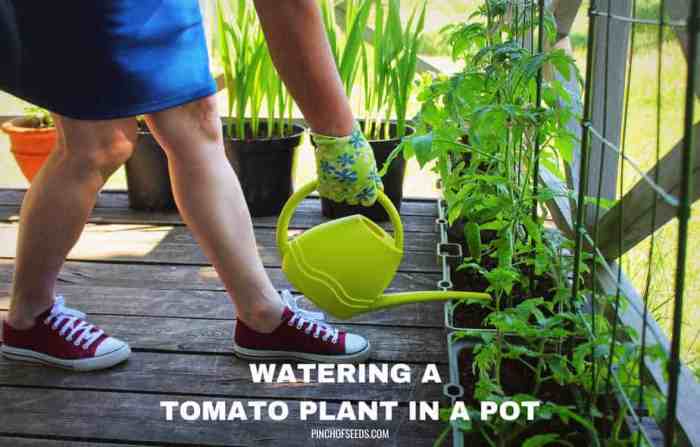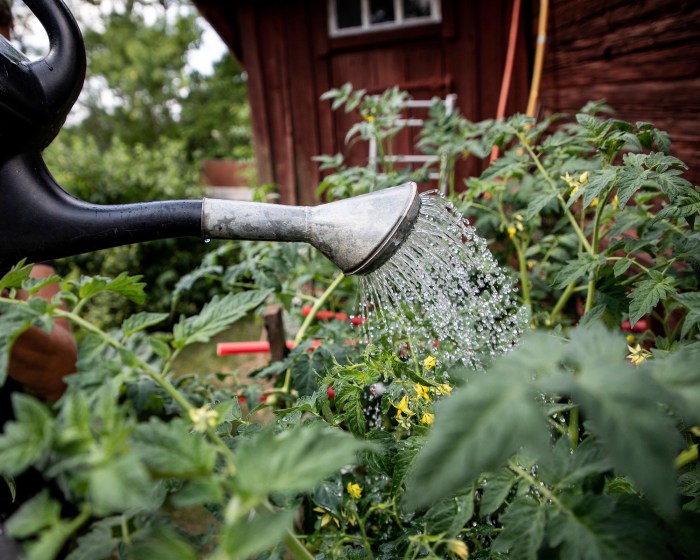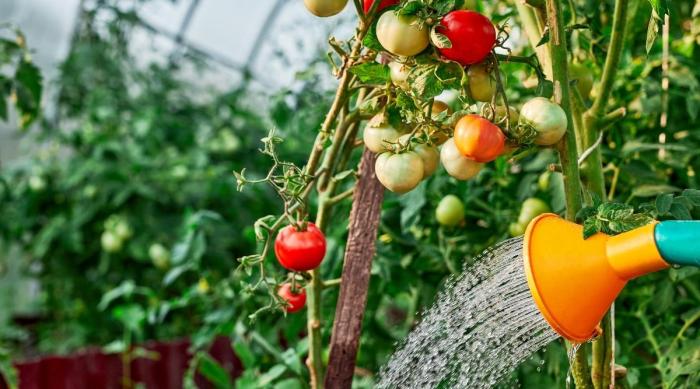How Do You Water Tomato Plants?
Watering Tomato Plants: How Do You Water Tomato Plants

Source: pinchofseeds.com
How do you water tomato plants – Successfully growing juicy, flavorful tomatoes hinges significantly on proper watering techniques. Understanding the frequency, methods, and water requirements is crucial for healthy plant growth and a bountiful harvest. This guide provides a comprehensive overview of effective tomato plant watering strategies.
Watering Frequency

Source: futurecdn.net
The frequency of watering tomato plants depends on several interacting factors. Consistent moisture is key, but overwatering can be just as detrimental as underwatering.
- Sun Exposure: Plants in full sun will dry out faster than those in partial shade, requiring more frequent watering.
- Soil Type: Sandy soil drains quickly, needing more frequent watering than clay soil, which retains moisture longer.
- Plant Size: Larger, more established plants require more water than seedlings or young plants.
- Climate: Hot, dry climates demand more frequent watering than cooler, humid climates.
A general watering schedule follows:
- Seedlings: Water frequently, keeping the soil consistently moist but not soggy.
- Young Plants: Water deeply and regularly, allowing the top inch of soil to dry slightly between waterings.
- Fruiting Plants: Water deeply and consistently, especially during hot, dry periods. Maintain consistent soil moisture to support fruit development.
| Symptoms | Underwatering | Overwatering | Solutions |
|---|---|---|---|
| Wilting leaves | Leaves droop, soil is dry | Leaves droop, soil is soggy | Water deeply; improve drainage if overwatering |
| Yellowing leaves | Lower leaves yellow and dry | Lower leaves yellow and mushy | Water deeply; adjust watering frequency; check for root rot |
| Blossom-end rot | Dark, leathery spots on fruit | Can contribute to it indirectly due to poor nutrient uptake | Ensure consistent watering; check soil calcium levels |
| Stunted growth | Slow growth, small leaves | Slow growth, weak stems | Adjust watering; check for nutrient deficiencies |
Watering Methods
Several methods exist for watering tomato plants, each with its own advantages and disadvantages.
| Method | Advantages | Disadvantages | Best Use Cases |
|---|---|---|---|
| Drip Irrigation | Efficient water use, targeted watering | Initial setup cost, potential for clogging | Large gardens, established plants |
| Soaker Hoses | Even moisture distribution, less evaporation | Can be less precise than drip irrigation | Rows of plants, raised beds |
| Hand Watering | Flexible, allows for close observation | Labor intensive, potential for uneven watering | Small gardens, individual plants |
| Overhead Watering | Quick and easy | Encourages fungal diseases, water loss through evaporation | Generally not recommended for tomatoes |
Watering cans provide more control over water application, ideal for young plants or targeted watering. Hoses are faster for larger areas but can lead to overwatering if not carefully managed.
Proper hand-watering involves applying water directly to the soil at the base of the plant, avoiding wetting the foliage to prevent fungal diseases. A gentle, slow stream is best to allow for adequate absorption.
Water Requirements
The quality of water used for irrigation significantly impacts tomato plant health.
- pH Level: Slightly acidic water (pH 6.0-7.0) is ideal for tomatoes.
- Mineral Content: Avoid water with high salt content, which can damage plants.
Rainwater is excellent for tomatoes due to its natural pH and low mineral content. Collect rainwater in clean containers, ensuring they are covered to prevent contamination. Chlorine and fluoride in tap water can harm tomato plants; letting tap water sit overnight allows chlorine to dissipate.
Soil Conditions
Maintaining optimal soil moisture is essential for healthy tomato growth.
The ideal soil moisture level is consistently moist but not waterlogged. Check soil moisture by inserting your finger about an inch into the soil. If it feels dry, it’s time to water. Moisture meters provide a more precise measurement.
A simple soil moisture monitoring system can be created using readily available materials such as a length of rope or absorbent material placed in the soil, connected to a visual indicator (e.g., a small container of water). The indicator’s water level reflects the soil moisture level.
Troubleshooting Watering Issues
Several issues can arise from improper watering.
| Problem | Cause | Solution | Prevention |
|---|---|---|---|
| Yellowing Leaves | Underwatering, overwatering, nutrient deficiency | Adjust watering, check nutrient levels | Consistent watering, balanced fertilization |
| Wilting | Underwatering, overwatering, heat stress | Adjust watering, provide shade if needed | Consistent watering, proper mulching |
| Blossom-End Rot | Inconsistent watering, calcium deficiency | Ensure consistent moisture, supplement calcium | Consistent watering, calcium-rich soil amendments |
| Root Rot | Overwatering, poor drainage | Improve drainage, reduce watering | Well-draining soil, avoid overwatering |
Mulching and Soil Management
Mulching significantly improves water retention and reduces evaporation.
Organic mulches such as straw, wood chips, or shredded leaves retain moisture effectively. Apply a layer of mulch around the plants, leaving a few inches of space around the stems to prevent rot.
Visual Representation of Proper Watering, How do you water tomato plants

Source: epicgardening.com
Watering tomato plants effectively involves deeply soaking the soil, ensuring moisture reaches the roots. The key, however, lies in determining how frequently this deep watering is necessary, which depends heavily on factors like weather and soil type. To find the optimal watering schedule for your specific situation, consult this helpful guide on how often should you water tomato plants.
Once you’ve established the frequency, remember to water consistently at the base of the plant to avoid fungal diseases.
A healthy, properly watered tomato plant displays vibrant green leaves, strong stems, and vigorous growth. Young plants will show consistent growth and a healthy green color, while mature plants will have lush foliage and abundant fruit. An underwatered plant exhibits wilting leaves, dry soil, and stunted growth. An overwatered plant shows yellowing, mushy leaves, and potentially root rot.
The soil will be soggy and may have a foul odor.
Key Questions Answered
Can I use well water to water my tomato plants?
Well water can be used, but test its pH and mineral content. High mineral content can be detrimental.
How often should I check the soil moisture?
Check daily during hot, dry weather and every other day in milder conditions. Use your finger or a moisture meter.
What should I do if my tomato plants are wilting?
Wilting can indicate underwatering or root problems. Check the soil moisture and rule out other issues like pests or diseases.
My tomato plants have yellowing leaves. What’s wrong?
Yellowing leaves could indicate overwatering, underwatering, nutrient deficiencies, or disease. Investigate all possibilities.




















